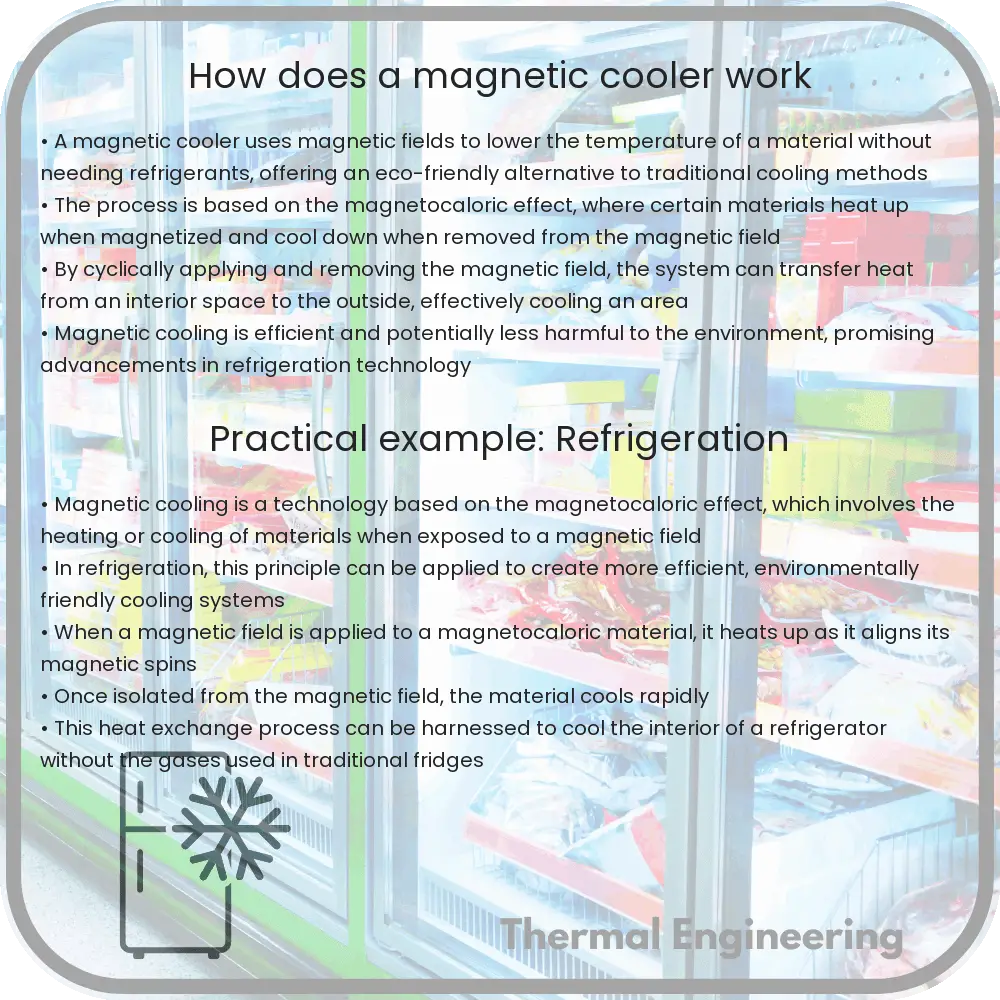Learn about the magnetocaloric effect, a phenomenon where materials change temperature when exposed to magnetic fields, pivotal in magnetic cooling technology.

Understanding the Principles of a Magnetic Cooler
Magnetic cooling is a fascinating technology based on the magnetocaloric effect (MCE), where certain materials exhibit a change in temperature when exposed to a changing magnetic field. This technology provides an innovative, environmentally friendly alternative to traditional refrigeration methods that rely on gas compressors and harmful refrigerants. In this article, we’ll explore how magnetic coolers work, the principles behind them, and their potential applications.
The Basics of the Magnetocaloric Effect
The magnetocaloric effect is a phenomenon observed in some materials, primarily metals and alloys, where their temperature changes when exposed to a magnetic field. This effect is most notable near the materials’ Curie temperature, the temperature at which a material’s magnetic properties undergo a significant change. The process involves two main stages:
- Magnetization: When a magnetocaloric material is placed within a magnetic field, its magnetic domains align with the field, causing the material to heat up.
- Demagnetization: Conversely, when the magnetic field is removed, the material’s magnetic domains return to a more disordered state, and the material cools down.
This temperature change during the magnetization and demagnetization process forms the core functionality of a magnetic refrigerator or cooler.
Components of a Magnetic Cooler
- Magnetocaloric Material: This is the core component that undergoes temperature changes. Gadolinium alloys are popular due to their strong magnetocaloric effects close to room temperature.
- Magnet: Permanent magnets or electromagnets are used to provide the necessary magnetic field that changes the temperature of the magnetocaloric material.
- Heat Exchange Mechanism: A fluid, such as water or glycol, is used to transfer heat in and out of the magnetocaloric material. This helps in managing the heating and cooling cycles effectively.
- Control System: This system controls the timing and intensity of the magnetic field, coordinating the overall refrigeration process.
How a Magnetic Cooler Operates
A magnetic cooler operates through a series of cycles that exploit the magnetocaloric effect for efficient cooling:
- Magnetization Phase: The magnetocaloric material is exposed to a magnetic field, heating up as its magnetic domains align.
- Heat Removal: The heated material transfers its excess heat to the heat exchange fluid, which is then carried away and dissipated in a heat sink.
- Demagnetization Phase: The magnetic field is reduced or removed, allowing the material to cool as its magnetic domains lose alignment.
- Heat Absorption: The now cooler magnetocaloric material absorbs heat from the surrounding environment (e.g., the refrigerator interior), effectively reducing the temperature of the space.
This cycle can be repeated continuously or controlled based on the cooling requirements, offering a highly customizable and efficient cooling process.
Advantages of Magnetic Cooling
Magnetic cooling offers several advantages over traditional refrigeration technologies:
- Eco-Friendly: It eliminates the need for harmful refrigerants, which are potential greenhouse gases and ozone depleting substances.
- Energy Efficiency: Magnetic coolers are potentially more energy-efficient, as the principal driving force is the magnetic field rather than mechanical compressors.
- Noise and Vibration: As there are no compressive moving parts, magnetic coolers operate much quieter and with less vibration.
Future Prospects and Challenges
While magnetic cooling technology holds tremendous potential, several challenges need to be addressed before it can become widespread. The cost and availability of materials with strong magnetocaloric effects are significant factors, as well as the development of more efficient magnetic systems and heat exchange mechanisms. Continued research and development are focused on overcoming these barriers, paving the way for a new generation of cooling technology.
Magnetic cooling represents an intriguing advance in refrigeration technology, promising a more sustainable and efficient way to manage cooling requirements in various applications, from consumer appliances to industrial systems.